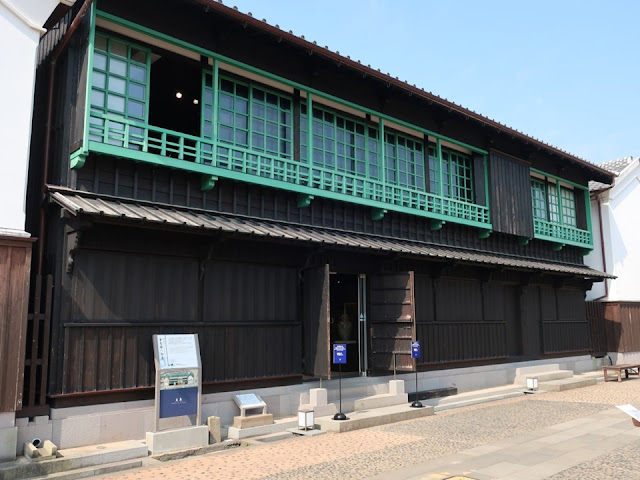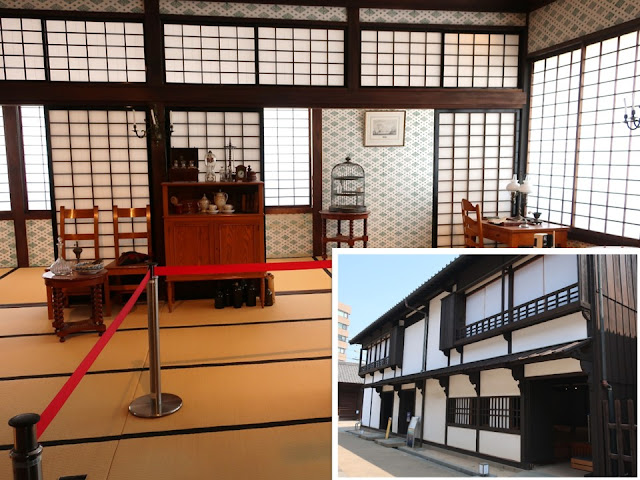During the Edo period (1603~1868), the shogunate (ruler) kept the national isolation policy. Japan had diplomatic relations with China, Korea and Netherland only. Its window was Nagasaki. Dejima was a Dutch settlement.
It is
written, “The artificial island of Dejima served as Japan’s only open window to
Europe from the time of construction in 1636 to the closing of the Dutch
Factory (the office of the trading company) in 1859.”
大抵の日本人は知っている出島。扇形の島で、オランダ人たちが暮らしていました。出島に出入りした日本人は、常駐する役人だけでなく、商人や遊女いました。現在、復元事業が進められていて、復元建物の中は展示スペースになっています。どんな暮らしだったのか、のぞいてみましょう。
Dejima was in Nagasaki Bay back then, but now it is in the center of Nagasaki City due to landfill. The buildings in Dejima are being rebuilt; exhibits there tell us their lives.
教科書でおなじみの出島は、明治時代に周りの海が埋め立てられて今は市街地にあります。
The photo above shows us old Dejima in Nagasaki Bay.
海に囲まれていた頃の出島の様子をうかがえる古写真です(長崎出島とロシア人居留地、長崎大学付属図書館蔵)。
Let’s go to Dejima through the main gate. (Many students came when I visited. It might be a school tour or an excursion.)
表門から入りましょう。(学生さんたちが頻繁に来ました)
The right side of the Dejima has been already rebuilt. Dutch and imported goods came from the gate at the end of the street. Major imports were silk in the 17th century, and were changed to sugar in the 18th century. On the other hand, Japan exported silver at first, then copper.
門を入って右側はほぼ復元されています。突き当たりの水門から、船からの物や人が入ってきました。江戸初期は生糸、中期以降は砂糖が主な輸入品でした。一方、主な輸出品は江戸初期は銀、その後は銅でした。
On the left side, there were space to raise livestock and to grow plants. Dutch had to keep their preferable foods; Japanese didn’t eat animal meat back then. At the end of street, there is a building of the Meiji period (1868-1912).
左側には、家畜を飼ったり植物を育てるスペースがありました。肉食ですからねえ。一番端は、明治期の洋風建築ゾーンになっています。
Clerk’s Quarters、筆者蘭人部屋
The building is divided into four sections; several clerks lived. The 2nd story parapets are painted in green which was popular in Netherlands at that time. Around fifteen Dutch stationed.
オランダ商館員の部屋で数人の筆者(書記役)が住んでいました。緑の塗料は当時のオランダでよく使われていたそうです。常駐のオランダ人は15人ほどでした。
The Dutch chief factor visited the shogun in Edo (old name of Tokyo). The number of the members was more than sixty which included chief, clerks, doctors and Japanese guards. It was ninety-day trip: I’m sure the trip was the most fun time for Dutch.
江戸参府の模型です。商館長以下、数人の医師に加え、日本人も同行し総勢60人以上になったそうです。往復90日、商館員には一番の楽しみだったでしょうね。
Chief factor’s residence、カピタン(商館長)部屋
This is the largest building in Dejima. 出島で一番大きな家です。
The vestibules (entrance) are on the second floor. His private room and office are also on the same floor.
大玄関は、2階にあります。私室、職務室とも2階です。
The hall is next to the vestibules. It recreated the setting of Christmas dinner, although Christianity was prohibited at that time. Therefore, they called it the different name. The kitchen was recreated in the building behind.
大広間(2階)。オランダ商館といえばパーティーのイメージです。クリスマスのディナーを再現していますが、禁教の日本では、名前を変えて祝いました。別棟の調理部屋も再現されています。
There is a guest room in front and a sun room in behind. The old picture shows us that musicians played in the guest room for the people in the hall. They could see the harbor and Dutch ships at anchor from the sun room. If I had been there, I had felt so sad by the nostalgy.
手前は客間、奥は涼所(すずみどころ)。客間にて、大広間で食事をする人のために音楽を演奏する絵が残っています。涼所からは、長崎港と停泊するオランダ船を見ることができたとのこと。私なら、故国を思い出して、とても辛い思いをしたでしょう。
There are exhibits about the trade and the everyday lives of clerks. We can play the boardgame.
一階では、貿易と共に、オランダ商館員の日常生活に関する展示があります。ボードゲームでは遊べます。
The photo above is a racket of badminton, which was introduced into Dejima first in Japan. It’s necessary to do physical exercise for health. There is also a billiard table. I’m sorry for the cramped life.
バドミントンのラケットです。「バドミントン伝来之地」という碑も立っています。体を動かすことは必要ですよね。ビリヤードの台もありました。いずれにせよ、窮屈な暮し可哀想です。
First
ship captain’s quarters、一番船船頭部屋
In the early 19th century, two Dutch ships arrived at Nagasaki every summer and departed in November. While in port, the first ship captain stayed the room above. The other crew members stayed on the ships. I never believe they stayed like a lamb for four months. Factory clerks used the room while ships weren’t.
オランダ船は、気候が安定している夏に二隻で来港し(19世紀初頭)、11月頃まで長崎に停泊しました。上は商館事務員の部屋ですが、停泊中は、一番船の船長が滞在しました。船員たちは船で過ごします。約四ヶ月、おとなしく船で過ごしていたとは思えません。
Warehouse、蔵
There were seventeen warehouses in total: five of them were rebuilt. The photo above is No.3 Warehouse. The models of sugar bag are set there. The warehouse was called “carnation warehouse”: Dutch gave the names of flowers to them. They were cool!
The highway on which sugar was transported was named “Sugar Road” recently.
蔵は五カ所復元されています。十七番蔵までありました。三番蔵の中には、輸入した砂糖が積まれています。オランダ人は蔵に花の名前を付けていて、三番蔵はピンクのカーネーションを意味する「アニェリール」という名前でした。粋ですね。
ジャワ島で生産された砂糖は、九州の玄関口・小倉まで陸路で運ばれた後、船で大阪へと運ばれました。長崎と小倉を結ぶ長崎街道は、「シュガーロード」として観光PRされています。
In No.2 Warehouse (maybe), imported and exported goods are explained in detail. We can see the remaining structure (lower left), too. There are abundant exhibits in Dejima.
二番蔵だと思いますが、輸出入品が丁寧に説明、展示されており、発掘された床下の遺構(左下)も見学できます。とにかく、出島内の展示物が多いです。
The Western culture was also imported to Japan through Dejima, such as liquors (beer etc.), chocolate, cameras and pianos. Most of them were everyday goods of Dutch residents. Japanese officials and others introduced them and those things were spread across Japan. Some of them were gifts to courtesans.
文化も渡ってきました。ビールなどの酒類、チョコレートなどの嗜好品、カメラやピアノ。商館員が使用していたこれらの品は、出島への出入りを許された役人らによって一般に広まったそうです。遊女へのプレゼントもありました。
Japanese officials’ office、乙名(おとな)部屋
They managed daily affairs including support of Dutch employees. They were selected from the merchants in Nagasaki. They also prevented smuggling.
こちらは、出島の管理を行った乙名(おとな)の家です。長崎の有力町人から奉行が選任され、貿易期間中はここに駐在しました。密貿易もチェックしました。
The title of the panel is “Japanese People on Dejima: Things Left Behind by Courtesans”. Accessories and toys were excavated, which were brought to Dejima. A few of the ladies gave birth.
出島には人夫や遊女たちも出入りしました。彼女たちが持ち込んだ指輪や遊具も出土されています。
The photo above is one to fifteenth scale model of Dejima. I knew there were many human dramas in the small artificial island.
出島の1/15模型も展示されています。狭い人工島の中で、たくさんの人間ドラマがありました。
China town is near Dejima site. It was crowded because of lunch time. I ate noodle called “Sara (plate) Udon”, it’s good!
Behind China
town, there is a site of the Chinese settlement; I introduced it on the article
of “NagasakiMuseum of History and Culture (1/2)“.
中華街はすぐ近くです。お昼時だったので賑わっていました。太麺の皿うどん(汁なしチャンポン)をいただきました。美味しかったです。
中華街の先に、唐人屋敷跡があります。こちらは、“長崎歴史文化博物館 part1“で紹介しています。
Visited in
May, 2022
Official
website: https://nagasakidejima.jp/english/
https://nagasakidejima.jp/ (in Japanese),
accessed in December, 2022
Previous
post (museum in the same city): Nagasaki Museum of
History and Culture (2/2)、長崎歴史文化博物館 part2
Next post (old house related to a hero (Sakamoto Ryoma) in the end of the Edo period): Kameyama Shachu memorial museum、亀山社中記念館





















Comments
Post a Comment